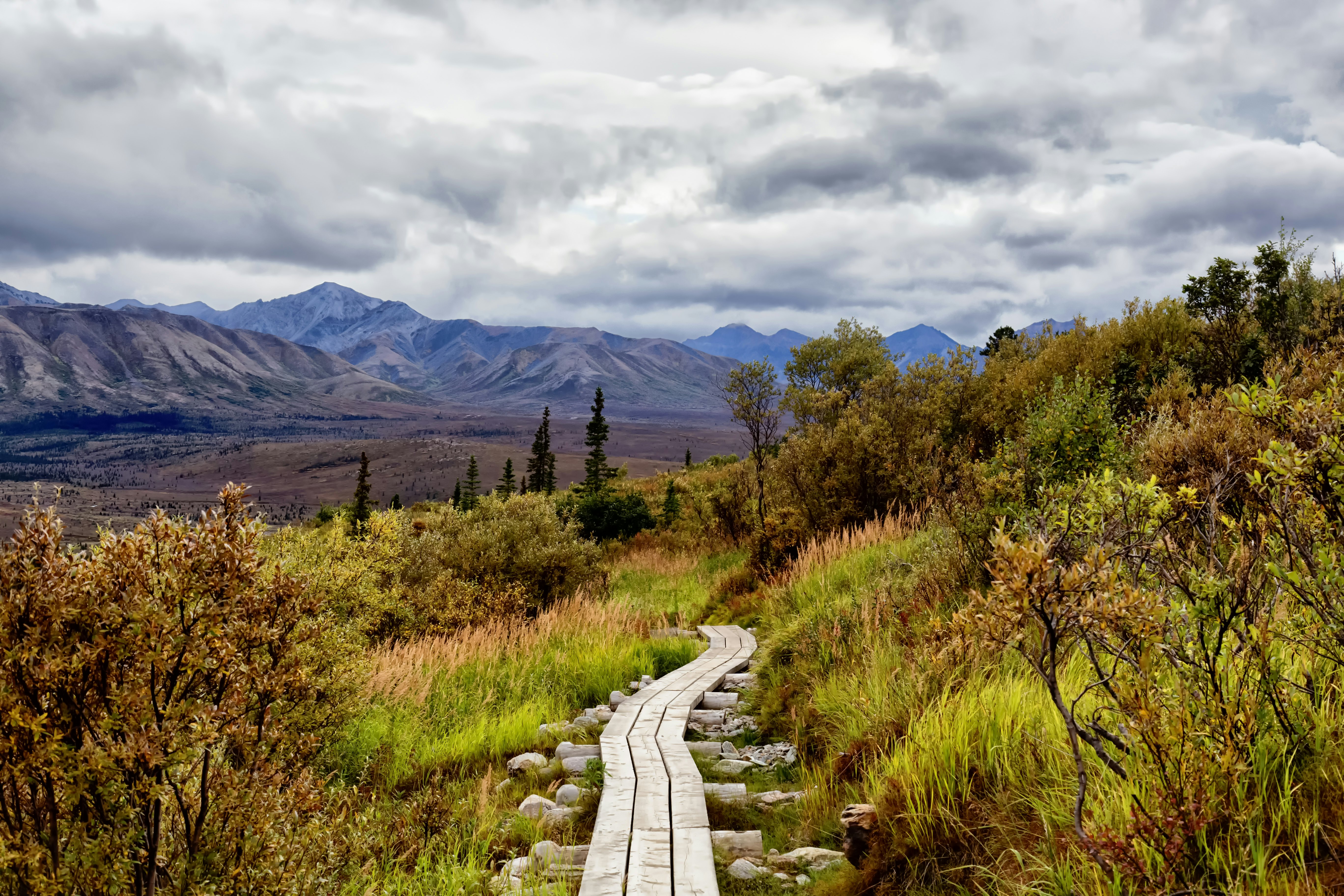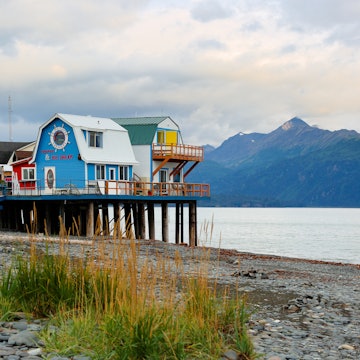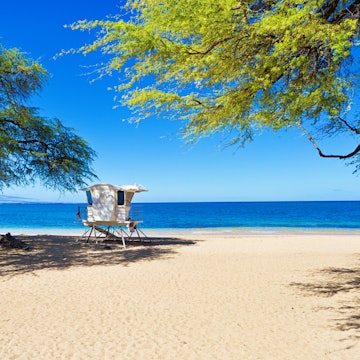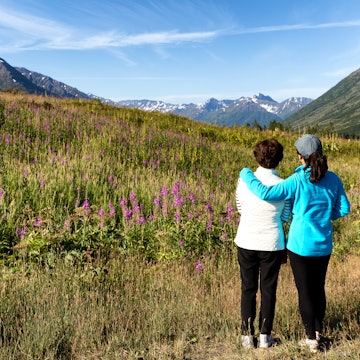

A green transit bus traveling through Denali National Park. Marcel Goldhardt/Shutterstock
In a landscape sparsely populated with people but covered in spruce forests, taiga, tundra and lakes, a singular physical force reigns supreme – the 20,310ft imposing elevation of Denali – the mountain that dominates its eponymous national park in Alaska. Denali National Park and Reserve is everything you would expect from the USA's wild-and-wonderful northernmost state – incredible scenery, abundant wildlife and year-round outdoor recreation opportunities.
It’s also one of the most accessible national parks in Alaska, thanks to the George Parks Highway and Alaska Railroad traversing its southeastern boundary and providing links to both Anchorage and Fairbanks.
Start planning your trip to Denali with this guide. However, before visiting any US national park, visitors should be aware that staffing cuts in the National Park Service (NPS) are having an impact on the amenities available.

When should I go?
Denali National Park and Preserve is open year-round, but the bulk of guest services are primarily available between late May and mid-September to accommodate the thousands of people who arrive each summer. During this time, visitor centers, hotels, restaurants and tour operators are in full swing, and the park and surrounding communities of Cantwell, Healy, and Nenana Canyon (also called “Glitter Gulch”) bustle with activity.
Winter operations are much more subdued, with only the Murie Science and Learning Center open as a de facto visitor center. The park service grooms the trail systems around this area, making for excellent cross-country skiing or fat biking conditions. Additionally, Park Rd is closed to vehicle traffic beyond this central area so people are welcome to ski, snowshoe or ride as far as they desire with no concern for cars or buses.
How much time should I spend in Denali?
It’s common for first-time visitors to think they can breeze through all the park’s attractions in a day or two before heading on to Alaska's many other attractions. While this strategy is possible, it’s not ideal for those who truly want to become acquainted with this unique and magnificent environment.
We suggest spending at least three nights in the greater Denali area and one full day devoted to the Park Rd route, either on board a tour or shuttle bus, or via the many hiking trails criss-crossing the park. Save the other days for rafting, biking, visiting sled dog kennels and dining in the communities around the park boundaries.

Is it easy to get around Denali?
You can get to Denali National Park and Preserve via the George Parks Hwy north or south from Anchorage or Fairbanks, respectively. The Alaska Railroad offers service daily during the summer months and weekly in the winter. There is also motorcoach transportation available from either Seward or Anchorage, and van transfers are available from Fairbanks.
However, traveling within the park does present a few challenges. Visitors may only drive in private vehicles for the first 17 miles as far as the Savage River Check Station; after this point, everyone needs to use a bus to explore the park.
The park has several campgrounds available, but a private vehicle is a must if you plan to stay elsewhere during your visit. You can rent a car in either Fairbanks or Anchorage to get around the areas outside the park and visit it daily.
What is a Narrated Tour Bus?
For those wanting to travel further and learn more about the history, flora and fauna of the park, a Narrated Tour Bus (as they're known locally) is a good option and features a trained naturalist who both drives the bus and narrates the trip. Two types of these trips are available to Denali National Park visitors and they operate between late May and early September. Pricing is between $51–$144.50 per person, depending on tour and age, and the buses are tan in color.
The five-hour Denali Natural History Tour travels from the entrance area to Primrose Ridge at Mile 15. Passengers will stop at several points along the way, with an hour of free time to explore off the bus. The Tundra Wilderness Tour is the longest-running tour (in various forms since 1923) in the park. This 5.5-hour trip travels along the open sections of the Park Rd corridor in search of wildlife and seasonal shifts in landscapes.
All tour bus trips begin and end at various locations around the park entrance. They do not pick up passengers at campgrounds along Park Rd and they are not designed for passengers to disembark and re-board outside of scheduled stops. They are the perfect option for those with limited time, mobility issues or travelers who want to gather more in-depth information about the park. Wheelchair-accessible buses are available and all stops are wheelchair accessible.
The daily schedule for each bus tour varies depending on demand – check the official booking page for additional information.

What about Denali Transit Buses?
These green buses offer services beyond Mile 17 and they depart and arrive at Denali Bus Depot. Reservations are essential and cost $33.50 per person (kids under 15 ride for free but need a reservation). These are operated on a hop-on-hop-off basis and give visitors more freedom than a narrated tour bus. However, boarding another bus depends on seat availability and you may have to wait a while.
What are camp buses?
This option is for travelers who need to access campgrounds or backcountry units further into the park and they have additional space for gear and bikes. Tickets cost $33.50 per person and kids under 15 ride for free (though they need a reservation).
Are there free shuttle buses?
Free shuttles operate across three routes – Savage River, Riley Creek Loop and Sled Dog Demonstration – that cover the visitor center and various other facilities. They are free for park visitors, operate daily in summer and are wheelchair accessible.
Transport tip: In 2014, an evolving landslide at Pretty Rocks kept national park crews on constant alert against damage that might prevent travel along this section of Park Rd. However, in 2021, the entire section of road at Mile 45.4 was closed due to a major failure of the surface. It remains closed today, and is expected to stay closed until at least summer 2026.

Top things to do in Denali
Your first stop should be at the main visitor center located a few miles from the Parks Hwy. Here you can pay park admission fees, get maps, learn about ranger-led programs and explore the many exhibits about park history, wildlife and mountaineering.
Visit the Murie Science and Learning Center
This learning hub is across the parking lot from the visitor center and focuses on the natural science side of Denali National Park. This facility also serves as the winter visitor center, and a popular activity is checking out snowshoes for a bit of free fun during the slower season.
Take to the hiking trails
Ringing the entire entrance is a network of fully accessible trails winding through birch, aspen and spruce forests. During the summer months, listen for an abundance of songbirds and keep an eye out for wildflowers, particularly lupine that grows in open areas and along roadways.
Try the McKinley Station interpretive trail toward Riley Creek Campground and take note of the original sites for the railroad station, a hotel and other buildings from the park’s early days. You can also stretch your legs between the park visitor center and the sled-dog kennels with a hike on the Rock Creek Trail.
For those looking to hike trails further into the park, the best bet is to drive or catch a shuttle bus to either Mountain Vista Day Use Area at Mile 13 or Savage River at Mile 15. Mountain Vista Loop Trail is a level, short (0.6-mile) trail perfect for catching a view of Denali on a clear day.
The Savage River parking area is a trailhead for two popular hikes; the Savage River Loop Trail and Savage Alpine Trail. For the loop portion, hike along either side of Savage River through a scenic canyon, Healy Ridge and Mt Margaret. The trail winds along meadows and scrub brush for about a mile before crossing the river.
The Savage Alpine Trail is tougher, traveling between Savage River Campground (next to Mountain Vista) at Mile 13 and the Savage River Canyon, traversing a high section of what’s called the Outer Range. In the summer, use the Savage River Shuttle for transit between these two trailheads.
Denali is unique in that off-trail hiking is permitted within the park’s backcountry, but there are occasional restrictions due to wildlife kills, animal dens or bird-nesting sites. It is imperative that backcountry hikers check in with park rangers at the visitor center before embarking on a non-trail adventure. Additionally, all members of the party will need to watch the park’s backcountry video series, either ahead of the visit or upon arrival.

Meet the pups at Denali Sled Dog Kennels
Meet the National Park Service's only canine ranger force. Hop on a shuttle from the main visitor center to see a demonstration of how they work (three times a day during peak season) and learn more about the history and importance of these four-legged rangers.
If you'd prefer to skip the shuttle and stretch your legs, take the Roadside Trail from the visitor center to the kennels – it's a 2-mile walk through beautiful birch and spruce forests.
My favorite things to do in Denali
I am a huge fan of America’s national park system and Denali is no exception. I love overnighting in either the Riley Creek or Savage River campgrounds, taking in the nature trails and ranger talks, and meeting other travelers as enthusiastic as I am about this pristine wilderness.
My favorite month to visit is late August when nights become cooler and an ever-so-slight shift toward fall begins to appear in Denali’s landscapes. Animals become more active, grasses and shrubs transition from green to brown or red, and mornings often feature a glaze of frost over the ground. It’s a wonder to see nature’s calendar at work this far north.
How much money do I need in Denali?
Like the rest of Alaska, goods and services are generally priced higher than other areas of the US. Expect to pay an average of $300 per night for a basic hotel room between May and September, and slightly less for a rustic cabin. For those tenting or traveling in an RV, campground spots vary from $30–60 per night (inside the park there are no electrical or water hookups). Plan ahead and make reservations as far in advance as possible – do not expect to find a room or campsite if you arrive without a booking.
Inside the park boundaries, there is just one sit-down restaurant next to the visitor center. The closest dining options outside the park can be found in the Nenana Canyon area, also known as “Glitter Gulch” for the array of tourist-themed shops. A cup of coffee will average $4, a full meal at least $25, and alcoholic beverages in the range of $7–20 depending upon the type. Nearly every business accepts credit cards.

Will I see bears?
Bears are a hot topic for Denali visitors and if you travel aboard a bus into the park itself, you’ll likely spy at least a few grizzlies prowling around the tundra.
Hikers should always be aware that the bears’ habitat is considered to be every inch of Denali National Park, so hiking in groups, making noise and carrying bear spray is a must, as is attending a bear safety lecture or watching bear safety videos at the Denali Bus Depot. Remember that firearms are prohibited in all US national parks.
What should I wear?
The weather around Denali is nothing if not fickle and you should be prepared for any sort of conditions at any time of year. At a minimum, dressing in non-cotton base layers with a sweater or fleece, and topping it all off with a rain jacket is smart. Include a warm hat and light gloves for chilly mornings or evenings, and be sure to wear sturdy footwear to stay safe on the uneven, rocky surfaces of Denali’s many trail systems.
Can I camp anywhere I want?
Inside the park boundary, those seeking to overnight in Denali’s wild spaces outside campgrounds must secure a backcountry permit. From May 12 to September 21, these free backcountry permits are issued in person at the Backcountry Information Center at the Denali Bus Depot no more than one day prior to travel.
You will need this permit to get Camper Bus tickets as well. It designates the region in which you’ll be staying, and hikers can find a map on the Denali National Park website’s Backcountry Unit Guide.

Is Denali a good place for kids?
The National Park Service does a spectacular job of making young visitors feel welcome and included in all aspects of indoor and outdoor activities. Here are some tips to ensure your tiny hikers have the time of their lives.
Don’t worry too much about taking the Park Rd bus trips, especially with young children. Focus instead on entrance area activities and the road to Savage River (17 miles from the entrance) that are full of ranger-led walks and talks, hikes, wildlife, and hands-on activities.
Be sure to see the Denali National Park sled dog kennels, and stay for the demonstration. Plus, there’s usually a litter of future sled dogs to see.
See the park in a new way by taking a float trip down the Nenana River. It’s a great opportunity to witness the power of Alaska’s waterways without too many rapids, but lots of fun.
















